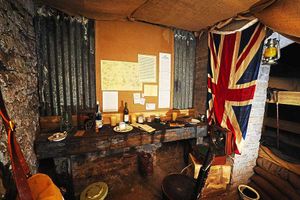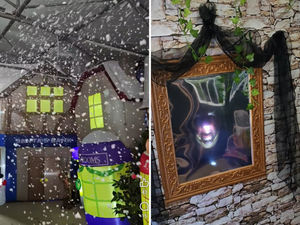Percy's letters bring home horror of war at Powis Castle
The horror experienced by local soldiers who were battling for their lives and country through mud-strewn World War One trenches is being brought to life at Powis Castle, with heartfelt letters and telegrams sent home from its own young tragic Welsh Guard – Percy Clive.

Powis Castle in Welshpool is revealing the sad story of Percy Herbert – the eldest son of Viscount Clive, 4th Earl of Powis – who died aged just 23 in the Battle of the Somme.
Gareth Sandham, Powis' house and collections manager said: "From diary entries made by the Countess of Powis, Percy Clive's mother and other sources, we have pieced together his tragic story on the battlefield and the emotions of his family who remained at home, worlds away from the front line, to commemorate the centenary of the battle of the Somme.
"By recreating a section of a World War One trench, we hope to immerse visitors in the story, bringing to life the turmoil experienced by Percy Clive and other soldiers at the time."
Mr Sandham said Percy was born into a life of wealth and privilege and as he approached his 21st year, it would have seemed that the world had been his oyster.
Mr Sandham said: "A new heir brought fresh hope to the estates: there were huge celebrations across the family lands in Powys and Shropshire at the time of his birth, although his coming-of-age revelries were curtailed by the outbreak of war on August 4, 1914."
And he said Percy, like so many other local and brave soldiers, was cut down in his prime.
"Clive had joined the newly-formed Welsh Guards in 1915 and served as an officer in the war," he said.
"He was involved in heavy fighting in the second battle of Ypres and later in the Somme offensive at Flers-Courcelette, where he was seriously injured, brought back to hospital in London but later died."
In the early 20th century the 4th Earl of Powis and his wife Lady Violet redecorated much of the castle and brought the garden back to life, introducing new varieties of flowers and plants from all over the world – but their life of luxury changed rapidly after war was declared.
Violet, Countess of Powis wrote in her 1913-14 journal ". . . the long, dreaded European war is upon us at last . . . Farewell to the old life of luxury – ease and comfort . . . The Angel of destruction is let loose."
But Clive would never march to Berlin and died shortly afterwards.
His death in 1916 was the first of a sequence of family tragedies that led to the castle passing into the care of the National Trust in 1952. The war had began for Viscount Clive in October 1914, when he was shipped out to Zeebrugge as part of the 2nd Battalion of the Scots Guards in the 7th Division. Two weeks later at Ypres the 1,000 strong 2nd Battalion lost over half their number during just one night of fighting.
Mr Sandham said: "As they step into the replica Somme trench and officers' dug-out, visitors will be transported back to life in WWI through period newsreels, battlefield objects and replica food packaging. They will get a sense of what it was to live as a soldier on the front line.
"The Somme offensive began on July 1, 1916 and the Welsh Guards arrived on August 9. During the battle of Flers-Courcellette, Viscount Clive was injured by a machine gun bullet in the leg. It took Clive a few days to travel from the front line to the hospital at Rouen.
"From the hospital in Rouen, Clive was sent home labelled 'Urgent' and treated at King Edward VII hospital in Grosvenor Square, London. His leg was badly broken and the bullet had not been removed."
Visitors to the castle can experience the war through the eyes of Percy until September 30, 2016.
Families will be able to dress as traditional WWI nurses and soldiers, take part in themed quizzes across the property and even train as a soldier on an assault course on the castle's Great Lawn.
They will also be able to wander through passages made of sandbags, corrugated metal sheets and wooden supports, with period items scattered throughout, as if the soldiers are still making use of the trenches.
Further events surrounding the anniversary of the Battle of the Somme are planned for later in the year.
The castle is open from 11am to 4pm daily. Admission costs from £6.18 adults and £3.09 children with admission to the cellar trenches included in the ticket price.





